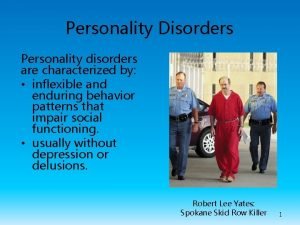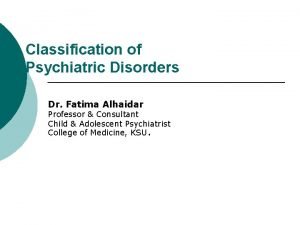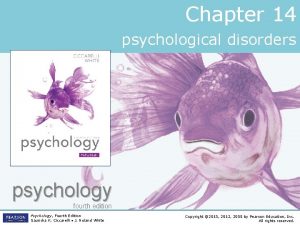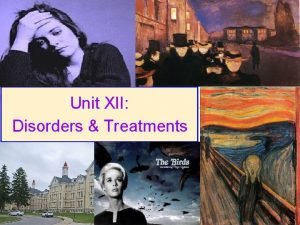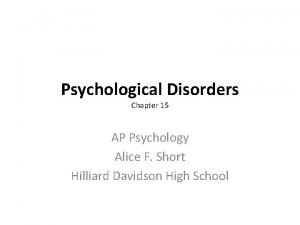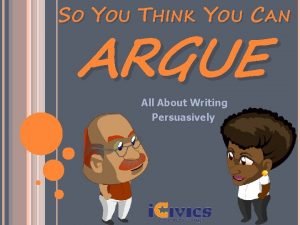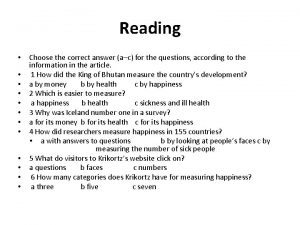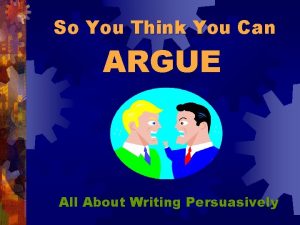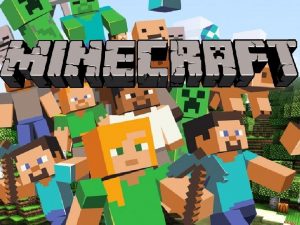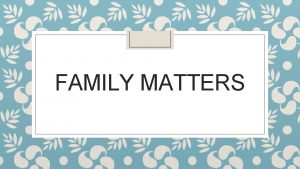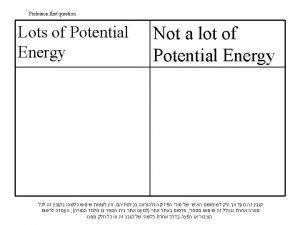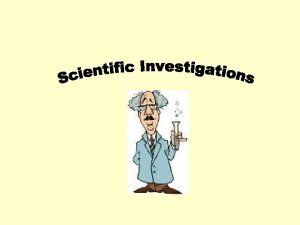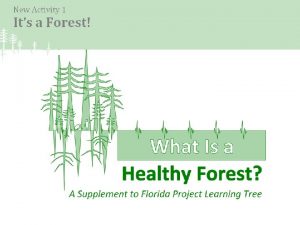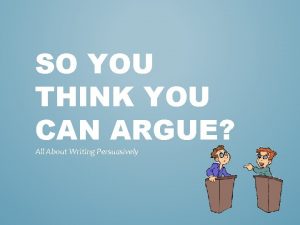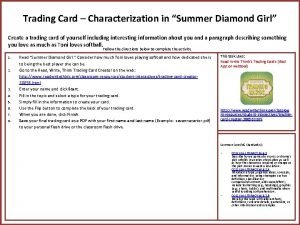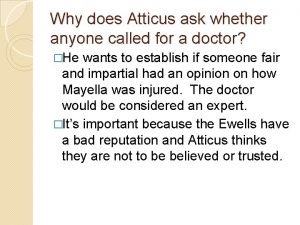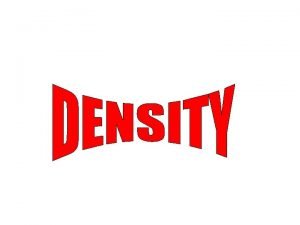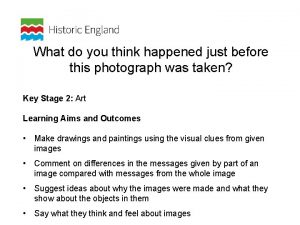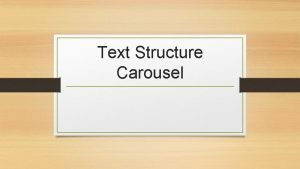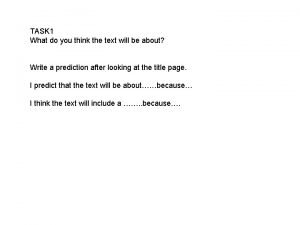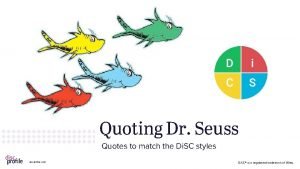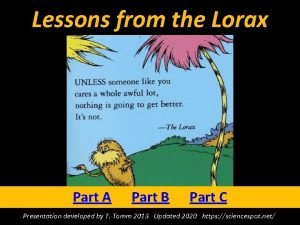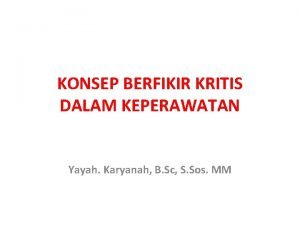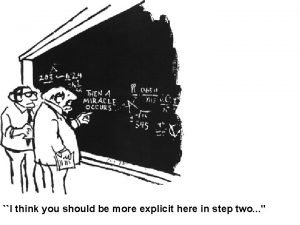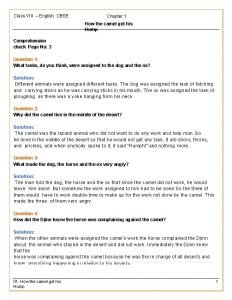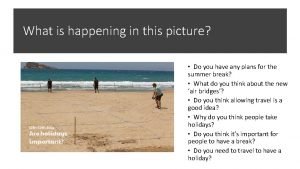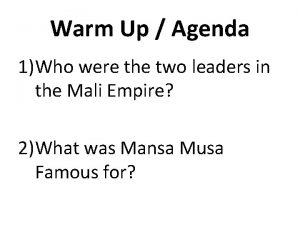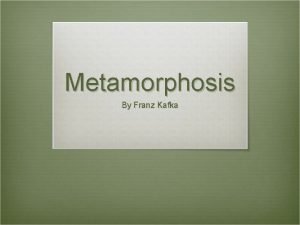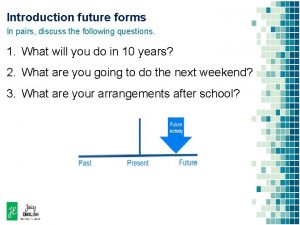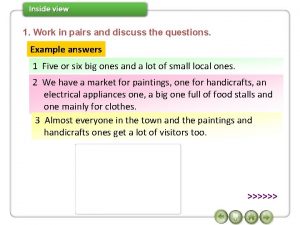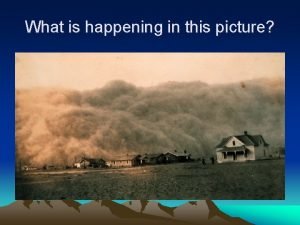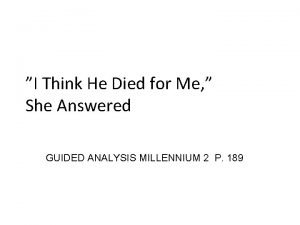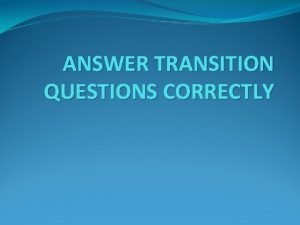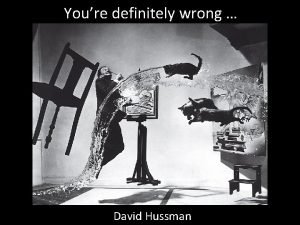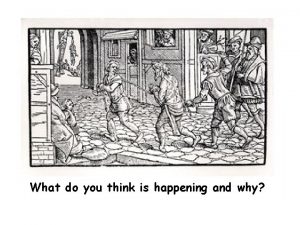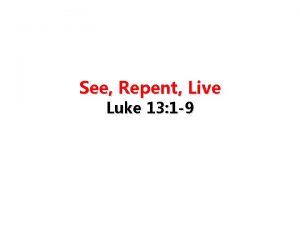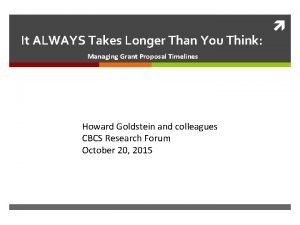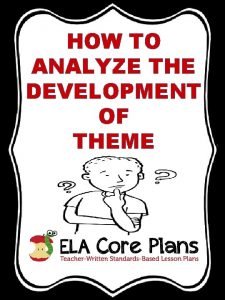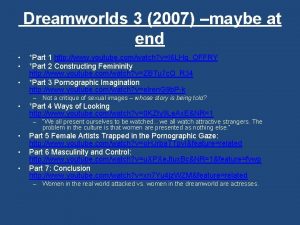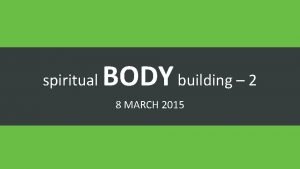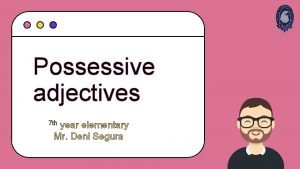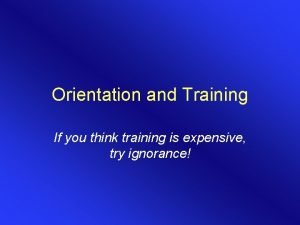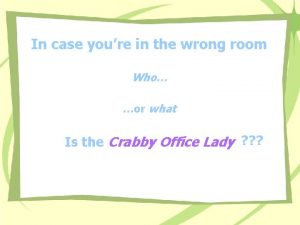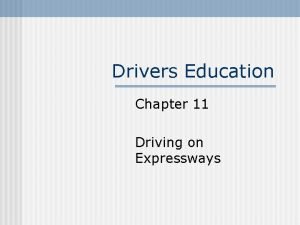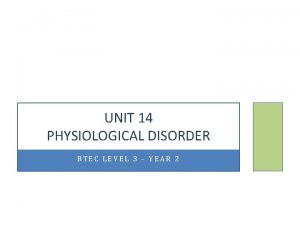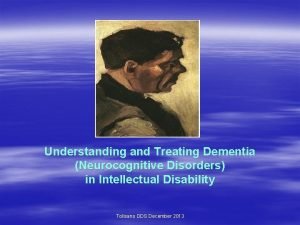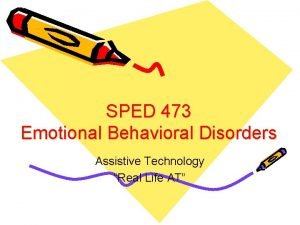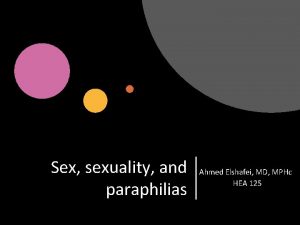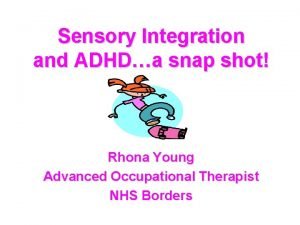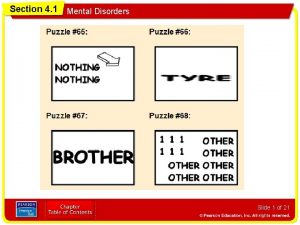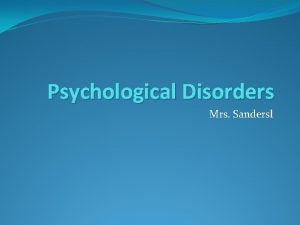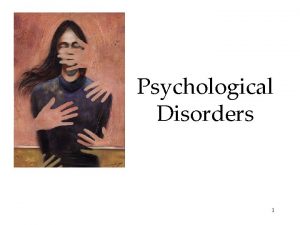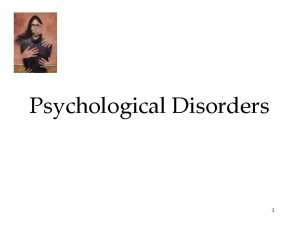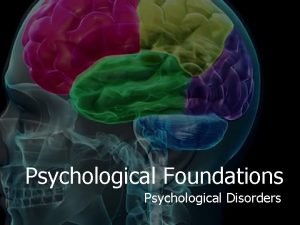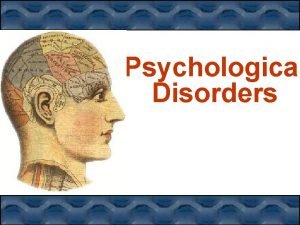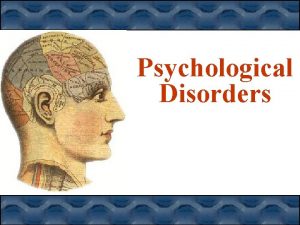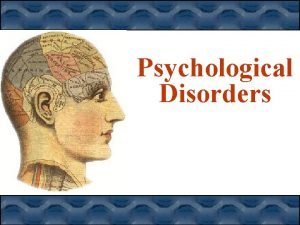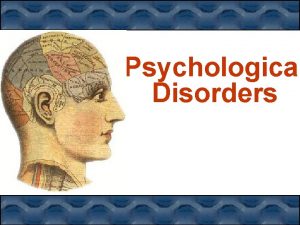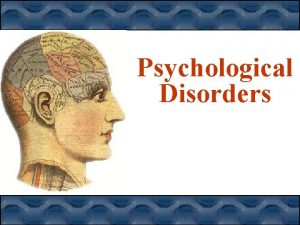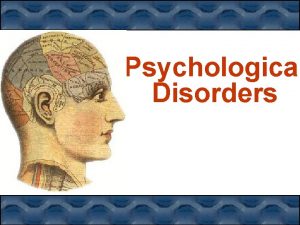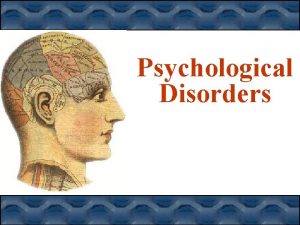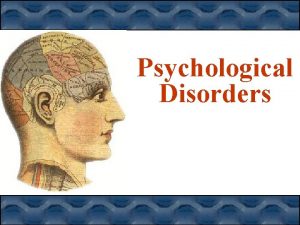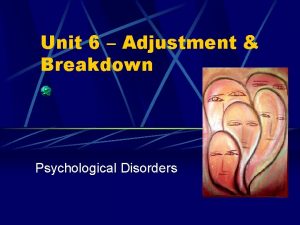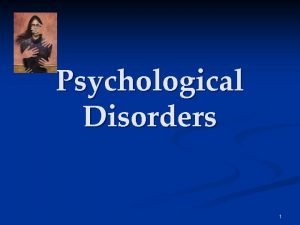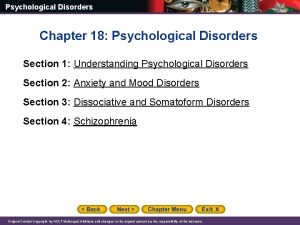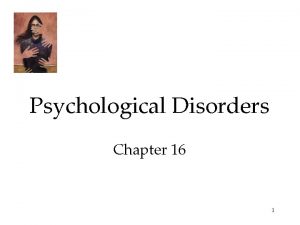Psychological Disorders Write What do you think a





































































































- Slides: 101

Psychological Disorders

Write What do you think? a definition for a psychological disorder. Do not give examples or define specific disorders- what does it mean to have a psychological disorder?

Disorders in History Psychological disorder (1959) = “the failure of the suffering individual to adapt to his or her environment” Social deviance as disease Who is to blame?

Mental Disorder - Today Pattern of behavioral/psychological symptoms that cause personal distress and impairs functioning

Personal Distress The behavior/symptoms causes significant personal distress to the patient (may not realize) –Potential harm to self or others

Psychological Disorder 1. 2. 3. 4. distressing & harmful; disruptive behavior is uncontrollable Unjustified, Irrational Must have personal distress and impaired functioning

Daily Impairs Functioning life functioning is impaired (one or both) –Work/School life –Home life –Varies throughout time/ culture

Question to Ponder Does having an abnormal behavior mean you have a disorder? When does one have an disorder?


How have disorders been classified? How would you classify someone with a “mental” problem? Cause or effect?

What would you do? What do you think is the best way to treat someone with a disorder? What has changed over the years in terms of how we look at disorders? Do you think people have always been treated fairly?

Video of Disorders http: //www. youtube. com/watch? v=Tz 1 XY 72 QUz 4&feature=related

Ancient causes of “madness” –movements of sun or moon lunacy- full moon (lunar)

Ancient “cures” –Exorcism –Lobotomy –Caged like animals, beaten, burned, castrated, mutilated –blood replaced with animal’s blood!

What do you think… Was the treatment benefical to patients? Really? Why

Today This is what we use today to classify people with disorders- DSM-IV-TR Why do we need a way to classify disorders?

Diagnosis DSM-IV-TR Diagnostic and Statistical Manual of Mental Disorders describes specific symptoms and diagnostic guidelines for psychological disorders – Provides a common language & comprehensive guidelines to help diagnose

Insanity legal only definition unable to determine between right & wrong or understand consequences

What do you think How easy do you think it would be to classify someone as insane?

Let’s Watch a brief intro http: //www. youtube. com/wa tch? v=_Cr 7 Iom. Sy 8 s

Psychological Disorders – here we come!!

Anxiety Disorders Anxiety = An unpleasant emotional state characterized by general, vague feelings of tension, fear and

When does this become a disorder? We all experience anxiety – if not experience anxiety you have issues… we will talk you about later So when do we move from normal anxiety to a disorder?

Anxiety Disorders differ from general feelings of anxiety in that… • Distressing, persistent feelings And/or • The behaviors that reduce anxiety… … begin to control and dominate life!

Anxiety Disorders are… Irrational (exaggerated or non existent threats, response is out of proportion) Uncontrollable (can not be “turned off”, even if the person wants to) Disruptive (interferes with

5 Types of Anxiety Disorders GAD Panic Phobias PTSD OCD

Let’s get a quick look at Generalized Anxiety Disorder http: //www. youtube. com/w atch? v=d. Rm. BJhtys 9 g

Generalized Anxiety Disorder (GAD) Constant worry about many issues w/o cause, seriously interferes with functioning – Physical symptoms headaches stomach aches muscle tension irritability

Panic Disorder Panic attacks— sudden episode of helpless terror with high physiological arousal (increased blood pressure, heart beat, temp. , sweating) Very frightening —sufferers live in fear of having them

Phobias Intense, irrational fears that may focus on ……. Inappropriate response to ………. . Yes this does not make sense to “normal” people

Bunch of Phobias You do not need to know the specifics, but you need to know the category…. If there is something to fear it can and will be feared by someone

Agoraphobia Fear of being in situations in which escape might be difficult, they don’t feel safe- public places, crowds, wide open spaces – Mostly confined to homes- they are safe there – One the most common

Natural environment type • the fear of heights (acrophobia) • the fear of lightning and thunderstorms (astraphobia).

Situational type –the fear of small confined spaces (claustrophobia) – being "afraid of the dark, " (nyctophobia). –Monophobia—fear of being alone –Gephyrophobia - Fear of crossing bridges. –Ligyrophobia — Fear of loud noises. –Xenophobia — Fear of strangers,

Blood/injection/injury type – the fear of medical procedures including needles and injections (aichmophobia) Algobphobia—fear of pain Pyrophobia—fear of fire Emetophobia — Fear of vomiting. Radiophobia— Fear of radiation or x-rays Hemophopia (Haemophobia) — Fear of blood

Animal type – the fear of spiders (arachnophobia) – the fear of snakes (ophidiophobia). Ailurophobia—fear of cats Myrmecophobia — Fear of ants. Cynophobia — Fear of dogs or of rabies. Mottephobia — Aversion to moths and butterflies.

the Other fear of the number 13 (triskaidekaphobia) the fear of clowns (coulrophobia). Anthropophobia—fear of men Ephebiphobia — Fear/dislike of teenagers. Zapatophobia - Fear of shoes, socks, or sandals.

Common and uncommon fears 100 Percentage 90 of people 80 surveyed 70 60 50 40 30 20 10 0 Snakes Being Mice Flying Being Spiders Thunder Being Dogs in high, on an closed in, and alone exposed airplane in a insects lightning In a places small house place at night Afraid of it Bothers slightly Not at all afraid of it Cats Driving Being In a a car crowd of people

Reading on PTSD

Posttraumatic Stress Disorder (PTSD) Follows events that produce intense horror or helplessness (traumatic episodes) Actual or threatened death and/or injury – War, Rape, Accidents, Attacks, Abuse, Rescue workers May be delayed after event- onset with trigger

Core symptoms include: – Frequent recollection of traumatic event, often intrusive and interfering with normal thoughts – Avoidance of situations that trigger recall of the event – Increased physical arousal associated with stress

Video clips

Obsessive-Compulsive Disorder (OCD) Obsessions—irrational, disturbing thoughts that intrude into consciousness Compulsions—repetitive actions performed to alleviate obsessions

The compulsions (actions) help to keep away the obsessions (thoughts) If the actions are not performed==anxiety Observable or mental compulsions

OCD Examples Obsessions about getting hurt, hurting someone, getting sick, contamination, symmetry Compulsions= cleaning, checking, hoarding, touching, counting, arranging, ordering, repeating phrases

Review What are the characteristics of a disorder? When does anxiety “regular” anxiety turn into a disorder? Make your charts – Disorder in the middle – 1 st square - Define it, 2 nd square -define all the types of disorders, 3 rd square – examples of each type, 4 th non-

Next set of disorders – Personality disorders

Personality Disorders Inflexible, maladaptive pattern of thoughts, emotions, behaviors stable over time and across situations deviate from the expectations of the individual’s culture

Antisocial Personality Disorder Might start as conduct disorder (children) Manipulative, charming, “con man” Cruel, destructive Lacking “conscience”, no guilt, no responsibility

Borderline Personality Disorder Instability of mood, selfimage, relationships Self-destructive behaviors, impulsive Fear of abandonment

Dependent Personality Disorder Excessive need to be taken care of Unable to make decisions or do things on own Leads to submissive, clinging behavior – fear of separation Inability to assume responsibility

Narcissistic Personality Disorder Grandiose sense of self importance success fantasies need for increased attention Excessive need for admiration arrogance – others are inferior

Paranoid Personality Disorder Pervasive but unwanted distrust and suspiciousness Assumes that other people intend to deceive, harm, exploit them

Review Personality disorders Make your charts – Disorder in the middle – 1 st square - Define it, 2 nd square define all the types of disorders, 3 rd square – examples of each type, 4 th non-examples of each type


Next set of disorders – dissociative disorders

Dissociative Disorders –literally a dis-association of memory –person suddenly becomes unaware of some aspect of their identity or history

Dissociative Disorders –unable to recall except under special circumstances (e. g. , hypnosis) –dissociative amnesia, dissociative fugue, dissociative identity disorder

Margie Dissociative Amnesia and her brother were recently victims of a robbery. Margie was not injured, but her brother was killed when he resisted the robbers. Margie was unable to recall any details from the time of the accident until four days later.

Dissociative Amnesia Memory loss the only symptom Too extensive to be explained by ordinary forgetfulness Often selective loss surrounding traumatic events – person still knows identity and most of their past

Dissociative Fugue Jay, a high school physics teacher in New York City, disappeared three days after his wife unexpectedly left him for another man. Six months later, he was discovered tending bar in Miami Beach. Calling himself Martin, he claimed to have no recollection of his past life and insisted that he had never been http: //www. msnbc. msn. com/id/21134540/vp/15384724#15384724 married.

Dissociative Fugue Amnesia with a journey involved – often with identity replacement – leaves home – develops a new identity – apparently no recollection of former life If fugue wears off – old identity recovers – new identity is totally forgotten

Dissociative Identity Disorder (DID) Norma has frequent memory gaps and cannot account for her whereabouts during certain periods of time. While being interviewed by a clinical psychologist, she began speaking in a childlike voice. She claimed that her name was Donna and that she was only six years old. Moments later, she seemed to revert to her adult voice and had no recollection of speaking in a childlike voice or claiming that her name was Donna.

Dissociative Identity Disorder 2 or more distinct personalities manifested by the same person at different times, VERY rare and controversial disorder Most report recall of torture or sexual abuse as children and show symptoms of PTSD Pattern typically starts prior to age 10 (childhood)

Let’s Read Let’s watch a video

What Review are the different types of dissociative disorders? Make your charts – Disorder in the middle – 1 st square - Define it, 2 nd square define all the types of disorders, 3 rd square – examples of each type, 4 th non-examples of each type

Mood disorders… what are they?

Mood Disorders Significant and persistent disruption in mood, causing impaired cognitive, behavioral, and physical functioning – Major depression –Dysthymic disorder –SAD – Bipolar disorder


Major Depression extreme and persistent feelings of despondency, worthlessness and hopelessness that disturb everyday functioning Most common disorder… 10% of the population

Symptoms of Major Depression Emotional—sadness, hopelessness, guilt, turning away from others Behavioral—tearfulness, dejected facial expression, loss of interest in normal activities, slowed movements and gestures, withdrawal from social activities

Cognitive—difficulty thinking and concentrating, global negativity, preoccupation with death/suicide Physical—appetite and weight changes, excessive or diminished sleep, loss of energy, global

treatment

• Difficult to sleep, to eat, to think, to concentrate • May have suicidal thoughts, may not be able to carry out plan

Chronic, Dysthymic Disorder low-grade depressed feelings that are not severe enough to be major depression May develop in response to trauma, but does not decrease with time Usually does not severely impair functioning Over two years

Seasonal Affective Disorder Episodes of depression occur in fall and winter then subside in spring and summer (Seasonal regularity)

Bipolar Disorders Mood levels swing from severe depression to extreme euphoria (mania), can have “normal” in between No regular relationship to time of year (SAD) Can vary in length of time for depression and mania

Must have at least one manic episode – Supreme selfconfidence – Grandiose ideas and movements, little effort in carrying out plans – Flight of ideas Aggressive, hostile, wild, incomprehensib le, violent

PET scans show that brain energy consumption rises and falls with emotional swings Depressed state Manic state Depressed state

Review of Mood Disorders Make your charts – Disorder in the middle – 1 st square - Define it, 2 nd square define all the types of disorders, 3 rd square – examples of each type, 4 th non-examples of each type

The disorder Schizophrenia

“Psychotic” loss of contact w/realityirrational, distorted

Schizophrenia Disordered thoughts/ communication s/ inappropriate emotions, bizarre behavior

Symptoms of Schizophrenia –Hallucination s Seeing & hearing things that are not there Command (something/ someone

Symptoms of Schizophrenia –Delusions Persecution (they’re out to get me’ paranoia) Grandeur (“God” complex, megalomania) being controlled (the CIA is controlling my brain with a radio signal)

Symptoms of Schizophrenia disorganized word salad) speech (e. g. , – jumping from idea to idea without the benefit of logical association – Para logic—on the surface, seems logical, but seriously flawed e. g. , Jesus was a man with a beard, I am a man with a beard, therefore I am Jesus

Symptoms of Schizophrenia Disorganized behavior – behavior is inappropriate for the situation e. g. , wearing sweaters and overcoats on hot days – Emotion is inappropriately expressed no emotion at all in face or speech, laughing at very serious things, crying at funny things

Types of Schizophrenia Paranoid type delusions of persecution, believes others are spying and plotting delusions of grandeur, believes others are jealous, inferior, subservient

Catatonic type unresponsive to surroundings, purposeless movement, parrotlike speech usually marked by immobility for extended periods

Disorganized type –disorganized speech and behavior –Childlike –Inappropriate emotions –delusions and hallucinations with little meaning

Review of Schizophrenia Make your charts – Disorder in the middle – 1 st square - Define it, 2 nd square define all the types of disorders, 3 rd square – examples of each type, 4 th non-examples of each type

Somatoform Disorders

Somatoform Disorders are characterized by the presence of physical symptoms that cannot be explained by a medical condition or another mental illness

Hypochondrias is refers to an excessive preoccupation or worry about having a serious illness.

Hypochondria is often characterized by fears that minor bodily symptoms may indicate a serious illness, constant self-examination and self-diagnosis, and a preoccupation with one's body.

With Conversion Disorder, patients present with neurological symptoms or deficits that affect voluntary motor or sensory function such as numbness, paralysis, blindness, etc. . It is thought that these problems arise in response to difficulties in the patient's life.

Body Dysmorphic Disorder is a preoccupation with an imagined or minor defect in appearance which causes clinically significant distress or impairment in social, occupational, or other important areas of functioning.

Body Dysmorphic Disorder. The disorder generally is diagnosed in those who are extremely critical of their physique or self-image even though there may be no noticeable disfigurement or defect, or a minor defect which is not recognized by most people. Too Ugly To Live - Part 1

Review Let’s make a graphic organizer: Center somatoform disorders, top left – define of the whole disorder, top right – specific disorders and definitions Bottom left – examples of each disorder

Factitious Disorders

People with factitious disorders intentionally produce or fake physical or psychological symptoms in order to receive medical attention and care. For example, an individual might falsely report shortness of breath to gain admittance to a hospital, report thoughts of suicide to solicit attention, or fabricate blood in the urine or the symptoms of rash so as to appear ill
 Dream with eyes open
Dream with eyes open Chapter 18 psychological disorders
Chapter 18 psychological disorders Psychological disorders characterized by inflexible
Psychological disorders characterized by inflexible Psychological disorders
Psychological disorders Chapter 18 psychological disorders
Chapter 18 psychological disorders Chapter 14 psychological disorders
Chapter 14 psychological disorders Chapter 14 psychological disorders
Chapter 14 psychological disorders Bipolar disorder meaning
Bipolar disorder meaning Ap psychology chapter 15 psychological disorders
Ap psychology chapter 15 psychological disorders If you think you can you can poem
If you think you can you can poem Robin and jay poem
Robin and jay poem Think family ni
Think family ni Have a daughter so you can argue
Have a daughter so you can argue Choose the correct answers a-c a person who is
Choose the correct answers a-c a person who is Alan and susie an argument
Alan and susie an argument Minecraft facts
Minecraft facts What comes to mind when you hear the word family
What comes to mind when you hear the word family You have more potential than you think
You have more potential than you think When you hear the word scientist what comes to mind
When you hear the word scientist what comes to mind What do you think of when you hear
What do you think of when you hear You can argue
You can argue Read write think
Read write think Read think talk write cycle
Read think talk write cycle Read write think trading card
Read write think trading card Concrete tree poem
Concrete tree poem Why does atticus ask bob ewell to write his name
Why does atticus ask bob ewell to write his name Mass volume density
Mass volume density What do you think happened in the image?
What do you think happened in the image? What are these people doing in the picture?
What are these people doing in the picture? Think before you dig
Think before you dig Why did montresor seek revenge
Why did montresor seek revenge Main idea 2 being a clown answer key
Main idea 2 being a clown answer key What do you think the text is about
What do you think the text is about Rules of netiquette in ict
Rules of netiquette in ict Oh the thinks you can think quotes
Oh the thinks you can think quotes Example of types of media
Example of types of media A tree falls the way it leans meaning
A tree falls the way it leans meaning Elemen berpikir kritis antara lain kecuali
Elemen berpikir kritis antara lain kecuali I think you should be more explicit here in step two
I think you should be more explicit here in step two Think before you lift
Think before you lift God is closer than you think
God is closer than you think What tasks do you think were assigned to the dog and the ox
What tasks do you think were assigned to the dog and the ox Mexicano contributions
Mexicano contributions What is happening
What is happening What comes to your mind when you think about god
What comes to your mind when you think about god How did the songhai empire strengthen islam?
How did the songhai empire strengthen islam? How does katniss surprise herself when she sees haymitch
How does katniss surprise herself when she sees haymitch Franz kafka
Franz kafka Work in pairs. discuss these questions in what other
Work in pairs. discuss these questions in what other I owe you an apology
I owe you an apology Disadvantages of product layout
Disadvantages of product layout Do you think jackson’s indian policy promoted democracy
Do you think jackson’s indian policy promoted democracy What do you think work in pairs and discuss the questions
What do you think work in pairs and discuss the questions Work in pairs answer the questions about the text
Work in pairs answer the questions about the text What is happening in the picture
What is happening in the picture What do you think these pictures represent?
What do you think these pictures represent? Where is it?
Where is it? Think back when you are in grade 1
Think back when you are in grade 1 Weekend? / what / do / last / you / did
Weekend? / what / do / last / you / did Why does scout stand up for walter
Why does scout stand up for walter Edith child since glasses was a worm has she
Edith child since glasses was a worm has she I think she died
I think she died What do you think about vietnam idol shows
What do you think about vietnam idol shows Beowulf reading check answers
Beowulf reading check answers I all of the questions correctly since
I all of the questions correctly since I think what you did was wrong david
I think what you did was wrong david Clapper dudgeon
Clapper dudgeon Think before you spit
Think before you spit Luke 13:2-5
Luke 13:2-5 Read the problem carefully identify the rate
Read the problem carefully identify the rate It always takes longer than you think
It always takes longer than you think What is the theme of the fox and the goat
What is the theme of the fox and the goat Did you ever think
Did you ever think Dreamworlds 3
Dreamworlds 3 What is involved in the process of exchanging messages
What is involved in the process of exchanging messages What makes a good firend
What makes a good firend What do you think of the topic
What do you think of the topic 1 corinthians 13:8
1 corinthians 13:8 What do you think about mr. deni
What do you think about mr. deni How does mr deni look like
How does mr deni look like If you think training is expensive try ignorance
If you think training is expensive try ignorance Crabby office lady
Crabby office lady Why do junior and rowdy climb the tree
Why do junior and rowdy climb the tree Think before you print
Think before you print Chapter 11 driving on expressways
Chapter 11 driving on expressways Why had m. loisel been saving 400 francs?
Why had m. loisel been saving 400 francs? You say you love rain
You say you love rain Agree or disagree questions about life
Agree or disagree questions about life Tell me what you eat and i shall tell you what you are
Tell me what you eat and i shall tell you what you are Follow you wherever you go
Follow you wherever you go Cache memory adalah
Cache memory adalah Health and social care unit 14
Health and social care unit 14 Unit 14 physiological disorders
Unit 14 physiological disorders Neurocognitive disorder
Neurocognitive disorder Bipolar and other related disorders
Bipolar and other related disorders Bipolar and other related disorders
Bipolar and other related disorders Flinders model
Flinders model Assistive technology for emotional and behavioral disorders
Assistive technology for emotional and behavioral disorders Nursing diagnosis for somatoform disorder
Nursing diagnosis for somatoform disorder Coprophilic disorder
Coprophilic disorder Types of sensory disorders
Types of sensory disorders Section 4-1 mental disorders answers
Section 4-1 mental disorders answers


